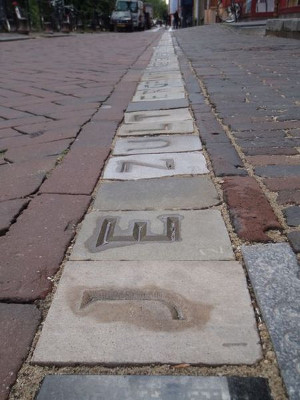An endless poem for the future grows in the stones of the streets in the center of the Dutch city of Utrecht1. One character per stone, one stone per week. Every Saturday, between 13:00 and 14:00, a stonemason carves the next letter into the next cobblestone. Every Saturday, as long as there are Saturdays. In months words are formed, with the years sentences. In time? the line of cobblestones will itself describe a U and a T in the city's center, and the residents in that time (the year 2350) can decide where it goes after that.
You have to begin somewhere to give the past its place, the present matters ever less. The further you are, the better. Continue now, leave your footprints. Forget the flash, in which you may exist, the world is your map. …
Written by a succession of poets from the city's poetry guild, the poem grows by about 5 meters a year. It takes about 3 years to publish a sentence.

As a theme and as an undertaking, the project appeals specifically to the passing of time and the benefit of future generations. Its creators have linked it explicitly to the 10,000-year clock4 being built in Texas' Sierra Diablo Mountain Range and the 7,000 oak trees5 planted in Kassel, Germany, by artist Joseph Beuys. Each cobblestone is sponsored6 by a citizen, often to commemorate a milestone such as a birthday, an anniversary, or a marriage.
Assignment
Replace each letter in a sentence by the number of times it appears in the sentence. Any character in the sentence that is not a letter, should simply be left in place. When counting the occurrences of a letter, no distinction should be made between uppercase and lowercase letters. However, there are three ways to count the occurrences of a letter. This is illustrated in the following sentence:
abcbaabccc aacbbbccba acabcacaab abbbbcacab ccabcacbba cbbbabbbcc
When looking into the past, we only count occurrences to the left of the letter:
abcbaabccc aacbbbccba acabcacaa-b a-bb-b-b-c-a-c-a-b- c-c-a-b-c-a-c-b-b-a- c-b-b-b-a-b-b-b-c-c- 0001122123 3443455665 67778899108 1191011121012111313 12131414141515151616 16171819172021221718
When looking in the present, we count occurrences in the whole sentence:
a-b-c-b-a-a-b-c-c-c- a-a-c-b-b-b-c-c-b-a- a-c-a-b-c-a-c-a-a-b- a-b-b-b-b-c-a-c-a-b- c-c-a-b-c-a-c-b-b-a- c-b-b-b-a-b-b-b-c-c- 18231923181823191919 18181923232319192318 18191823191819181823 18232323231918191823 19191823191819232318 19232323182323231919
When looking into the future, we only count occurrences to the right of the letter:
a-b-c-b-a-a-b-c-c-c- a-a-c-b-b-b-c-c-b-a- a-c-a-b-c-acaab- ab-b-b-b-cacab ccabcacbba cbbbabbbcc 17221821161520171615 14131419181713121612 1111101510998714 61312111085749 6538423761 2543021010
As we did in the examples above, on top of the sentence in which the letters were replaced by their number of occurrences, you should also write the sentence in which each letter is followed by zero or more hyphens, so that the letter and the hyphens consist of the same number of characters as the number of digits in the number of occurrences of the letter. For example, if there are 101 occurrences of the letter a, we write a-- because there are three digits in 101.
Input
A sentence, followed by a second line indicating where to count occurrences of the letters in the sentence:
-
past: count only to the left of a letter
-
present: count in the whole sentence
-
future: count only to the right of a letter
Output
The sentence whose letters are aligned with their number of occurrences, followed by a second line containing the sentence with each letter replaced by its number of occurrences. When counting occurrences, do not distinguish between uppercase and lowercase letters, and count only where indicated by the second line of input.
Example (past)
Input:
You have to begin somewhere to give the past its place, the present matters ever less.
pastOutput:
You have to begin somewhere to give the past its place, the prese-nt matte-rs e-ve-r le-ss.
000 0000 01 01000 020201304 13 1115 226 0113 242 10207, 538 21931016 13781124 122133 11456.Example (present)
Input:
You have to begin somewhere to give the past its place, the present matters ever less.
presentOutput:
You have- to be-gin some-whe-re- to give- the- past its place-, the- pre-se-nt matte-rs e-ve-r le-ss.
141 44315 94 115232 742151415415 94 23315 9415 3479 397 324115, 9415 341571529 24991547 153154 21577.Example (future)
Input:
You have to begin somewhere to give the past its place, the present matters ever less.
futureOutput:
You have- to be-gin some-whe-re- to give the past its place, the present matters ever less.
030 33214 82 013121 611120211310 70 0119 618 2255 044 11107, 306 0253402 0010312 2010 0010.